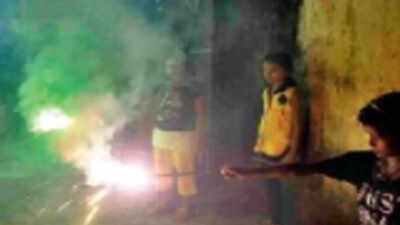Top Searches
- News
- City News
- kolkata News
- West Bengal: Kali Puja, Diwali bring AQI down from moderate to poor
West Bengal: Kali Puja, Diwali bring AQI down from moderate to poor
West Bengal: Kali Puja, Diwali bring AQI down from moderate to poor

In the five years prior to the pandemic, the air quality index (AQI) has turned from moderate to severe on Kali Puja-Diwali night and then remained poor for months due to the onset of winter.
KOLKATA: When the Supreme Court allowed green fireworks during the festivals, it also issued an important rider. If the ambient air quality dipped from moderate to poor, even green crackers would be banned. In the five years prior to the pandemic, the air quality index (AQI) has turned from moderate to severe on Kali Puja-Diwali night and then remained poor for months due to the onset of winter.
Track the pollution level in your city
An AQI of 101 to 200 is considered moderate; 201 to 300 poor; 301 to 400 very poor and above 500 severe.
Diwali day in 2020, when there was a blanket on fireworks, the ambient air had stayed moderate, resulting in the air quality staying moderate even after Diwali. WBPCB chairman Kalyan Rudra pointed out that it should be parents who should encourage children to celebrate Diwali in a manner that does not pollute. “Letting your child light fireworks is exposing her or him to toxic fumes and fine particulate matter,” he cautioned.
A day prior to Diwali in 2019, the PM2.5 count was 28.2µg/m3 A day after Diwali night, it shot up more than 100% to 58.9µg/m3. This year, Diwali is happening late in the year when thermal inversion will have a greater role to play in trapping the pollutants low in the atmosphere and keeping it there for the rest of the season.
The PM2.5 concentration in the city’s air after 2019 Diwali rose so sharply that breathing was as bad as smoking eight cigarettes. In 2018, it was worse post Diwali the air was as bad as smoking 12.5 cigarettes. These are the 24 hours average of PM2.5 concentration (not air quality index). Hourly concentration figures were much higher. Hourly PM2.5 count shot past 700µg/m3 in 2019 Diwali. In 2018, it zoomed past 1100µg/m3.
Environment activist Soumendra Ghosh pointed out that the piling up of particulate load in the lower strata of the atmosphere pushes the city’s pollution level beyond even Delhi. “PM2.5 plays havoc with vital organs. Air pollution kills more people worldwide each year than does AIDS, malaria, diabetes or tuberculosis,” said Arup Haldar, a senior pulmonologist.
Track the pollution level in your city
An AQI of 101 to 200 is considered moderate; 201 to 300 poor; 301 to 400 very poor and above 500 severe.
Diwali day in 2020, when there was a blanket on fireworks, the ambient air had stayed moderate, resulting in the air quality staying moderate even after Diwali. WBPCB chairman Kalyan Rudra pointed out that it should be parents who should encourage children to celebrate Diwali in a manner that does not pollute. “Letting your child light fireworks is exposing her or him to toxic fumes and fine particulate matter,” he cautioned.
A day prior to Diwali in 2019, the PM2.5 count was 28.2µg/m3 A day after Diwali night, it shot up more than 100% to 58.9µg/m3. This year, Diwali is happening late in the year when thermal inversion will have a greater role to play in trapping the pollutants low in the atmosphere and keeping it there for the rest of the season.
The PM2.5 concentration in the city’s air after 2019 Diwali rose so sharply that breathing was as bad as smoking eight cigarettes. In 2018, it was worse post Diwali the air was as bad as smoking 12.5 cigarettes. These are the 24 hours average of PM2.5 concentration (not air quality index). Hourly concentration figures were much higher. Hourly PM2.5 count shot past 700µg/m3 in 2019 Diwali. In 2018, it zoomed past 1100µg/m3.
Environment activist Soumendra Ghosh pointed out that the piling up of particulate load in the lower strata of the atmosphere pushes the city’s pollution level beyond even Delhi. “PM2.5 plays havoc with vital organs. Air pollution kills more people worldwide each year than does AIDS, malaria, diabetes or tuberculosis,” said Arup Haldar, a senior pulmonologist.
FacebookTwitterLinkedinEMail
Start a Conversation
end of article

